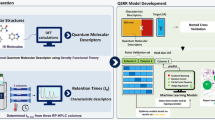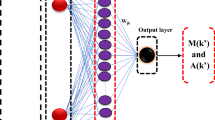Abstract
Reliable simulation of retention factor (k) is crucial in high-performance liquid chromatography (HPLC) method development. In this research, three different Artificial intelligence (AI) based models, namely the multi-layer perceptron (MLP), Support vector machine (SVM) and Hammerstein–Weiner (HW) models, were employed as well as three ensemble techniques, i.e., neural network ensemble (NNE), weighted average ensemble (WAE) and simple average ensemble (SAE) to predict k for HPLC method development. In this context, the pH and composition of the mobile phase (methanol) are used as the input variables with the corresponding Methyclothiazide (M) and Amiloride (A) as antihypertensive target analytes. The performance efficiency of the models was evaluated using mean square error (MSE), determination coefficient (R2), and correlation coefficient (R). The results obtained from the single models showed that MLP outperformed the other two models and increased the prediction accuracy up to 1% and 3% for the HW and SVM models, respectively, for the prediction of M. However, for the prediction of A, SVM outperformed the other two models and increased the prediction accuracy up to 7% and 6% for HW and MLP, respectively. In the ensemble technique, the results obtained for the prediction of both M and A demonstrated that NNE increased the performance accuracy by 14% of the single models. Also, NNE proved to be superior to the two linear ensembles and improved the prediction accuracy up to 14% and 2% for SAE and WAE, respectively, for the simulation of M with R2 = 0.9962 and 0.9949 for both calibration and verification, and up to 9% and 6% for A with R2 = 0.9606 and 0.9569 for both calibration and verification phases respectively. The overall results depicted the reliability and robustness of both the AI-based models and justified the enhancement capability for ensemble techniques for both the two analytes.











Similar content being viewed by others
References
Zisaki A, Miskovic L, Hatzimanikatis V (2014) Antihypertensive drugs metabolism: an update to pharmacokinetic profiles and computational approaches. Curr Pharm Des 21(6):806–822
Inés Toral M, Pope S, Quintanilla S, Richter P (2002) Simultaneous determination of amiloride and furosemide in pharmaceutical formulations by first digital derivative spectrophotometry. Int J Pharm 249(1–2):117–126
Munro K, Miller TH, Martins CPB, Edge AM, Cowan DA, Barron LP (2015) Artificial neural network modelling of pharmaceutical residue retention times in wastewater extracts using gradient liquid chromatography-high resolution mass spectrometry data. J Chromatogr A 1396:34–44
Wu J, Luo W, Wang X, Cheng Q, Sun C, Li H (2013) A new application of WT-ANN method to control the preparation process of metformin hydrochloride tablets by near infrared spectroscopy compared to PLS. J Pharm Biomed Anal 80:186–191
Sahu PK, Ramisetti NR, Cecchi T, Swain S, Patro CS, Panda J (2018) An overview of experimental designs in HPLC method development and validation. J Pharm Biomed Anal 147:590–611
Agatonovic-Kustrin S, Zecevic M, Zivanovic L, Tucker IG (1998) Application of neural networks for response surface modeling in HPLC optimization. Anal Chim Acta 364(1–3):265–273
Snyder LR, Dolan JW (2007) High-performance gradient elution: the practical application of the linear-solvent-strength model. Wiley, Hoboken
Agatonovic-Kustrin S, Zecevic M, Zivanovic L (1999) Use of ANN modelling in structure-retention relationships of diuretics in RP-HPLC. J Pharm Biomed Anal 21(1):95–103
D’Archivio AA, Giannitto A, Maggi MA (2013) Cross-column prediction of gas-chromatographic retention of polybrominated diphenyl ethers. J Chromatogr A 1298:118–131
Kouskoura MG, Kachrimanis KG, Markopoulou CK (2014) Modeling the drugs’ passive transfer in the body based on their chromatographic behavior. J Pharm Biomed Anal 100:94–102
Dehghanian E, Kaykhaii M, Mehrpur M (2015) Comparison of single best artificial neural network and neural network ensemble in modeling of palladium microextraction. Monatshefte fur Chemie 146(8):1217–1227
Pham QB, Abba SI, Usman AG, Linh NT, Gupta V, Malik A, Costache R, Vo ND, Tri DQ (2019) Potential of hybrid data-intelligence algorithms for multi-station modelling of rainfall. Water Resour Manag 33(15):5067–5087
Abba SI, Pham QB, Usman AG, Linh NT, Aliyu DS, Nguyen Q, Bach QV (2020) Emerging evolutionary algorithm integrated with kernel principal component analysis for modeling the performance of a water treatment plant. J Water Process Eng 33:101081
Elkiran G, Nourani V, Abba SI (2019) Multi-step ahead modelling of river water quality parameters using ensemble artificial intelligence-based approach. J Hydrol 577:123962
Amini I, Pal K (2018) Prediction of two-dimensional gas chromatography time-of-flight mass spectrometry retention times of 160 pesticides and 25 environmental organic pollutants in grape by multivariate chemometrics methods. Adv J Chem A 1(1):12–31
Marrero-Ponce Y, Barigye SJ, Jorge-Rodríguez ME, Tran-Thi-Thu T (2018) QSRR prediction of gas chromatography retention indices of essential oil components. Chem Pap 72(1):57–69
Shojaeimehr T, Rahimpour F (2018) Retention time modeling of short-chain aliphatic acids in aqueous ion-exclusion chromatography systems under several conditions using computational intelligence methods (artificial neural network and adaptive neuro-fuzzy inference system). J Liq Chromatogr Relat Technol 41(12):810–817
Korany MA, Mahgoub H, Fahmy OT, Maher HM (2012) Application of artificial neural networks for response surface modelling in HPLC method development. J Adv Res 3(1):53–63
Agatonovic-Kustrin S, Zecevic M, Zivanovic LJ, Tucker IG (1998) Application of artificial neural networks in HPLC method development. J Pharm Biomed Anal 17(1):69–76
Vasiljević T, Onjia A, Čokeša D, Laušević M (2004) Optimization of artificial neural network for retention modeling in high-performance liquid chromatography. Talanta 64(3):785–790
de Magalhães BEA et al (2020) Determination of phenolic composition of oilseed whole flours by HPLC-DAD with evaluation using chemometric analyses. Microchem J 155:104683
Abba SI, Usman AG, Selin IŞik (2020) Simulation for response surface in the HPLC optimization method development using artificial intelligence models: a data-driven approach. chemom Intell Lab. Syst 2:104007
El-shorbagy HI, Elsebaei F, Hammad SF, El-brashy AM (2019) Optimization and modeling of a green dual detected RP-HPLC method by UV and fluorescence detectors using two level full factorial design for simultaneous determination of sofosbuvir and ledipasvir: application to average content and uniformity of dosage. Microchem J 147(February):374–392
Aslam MA et al (2020) SVM based classification and prediction system for gastric cancer using dominant features of saliva. Nano Biomed Eng 12(1):1–13
Aboulwafa MM et al (2019) Authentication and discrimination of green tea samples using UV–vis, FTIR and HPLC techniques coupled with chemometrics analysis. J Pharm Biomed Anal 164:653–658
Celeste M, Galvão E, Rosa B, Ferreira E, Silva R, Caldas C (2019) Screening of Mangifera indica L functional content using PCA and neural networks (ANN). Food Chem 273:115–123
Tomi J et al (2020) Chemometrically assisted RP-HPLC method development for efficient separation of ivabradine and its eleven impurities. Acta Chromotagr 32:53–63
Huang XL, Xiong L, Wang YM, Xu F, Liang YQ, Wang XP, Wu HM (2019) Evaluation of quality of Salvia miltiorrhiza Bunge from different provenances by HPLC-DAD fingerprint combined with Chemometrics Method.. In: IOP conference series: earth and environmental science. IOP Publishing, Bristol
Chen H, Poon J, Poon SK, Cui L, Fan K, Yuen Sze DM (2015) Ensemble learning for prediction of the bioactivity capacity of herbal medicines from chromatographic fingerprints. BMC Bioinform 16(12):S4
Zeng J, Chai Q, Peng X, Li S (2019) Geographical origin identification for tetrastigma hemsleyanum based on high performance liquid chromatographic fingerprint. In: Proc.—2019 Chinese Automation Congress CAC 2019, pp 1816–1820
Pfeifer N, Leinenbach A, Huber CG, Kohlbacher O (2007) Statistical learning of peptide retention behavior in chromatographic separations: a new kernel-based approach for computational proteomics. BMC Bioinform 8:1–14
D’Archivio AA, Maggi MA, Ruggieri F (2015) Artificial neural network prediction of multilinear gradient retention in reversed-phase HPLC: comprehensive QSRR-based models combining categorical or structural solute descriptors and gradient profile parameters. Anal Bioanal Chem 407(4):1181–1190
Gaya MS, Zango MU, Yusuf LA, Mustapha M, Muhammad B, Sani A, Tijjani A, Wahab NA, Khairi MT (2017) Estimation of turbidity in water treatment plant using Hammerstein-Wiener and neural network technique. Indones J Electr Eng Comput Sci 5(3):666–672
Abba SI, Nourani V, Elkiran G (2019) Multi-parametric modeling of water treatment plant using AI-based non-linear ensemble. J Water Supply: Res Technol-Aqua 2:1–15
Abba SI, Saleh A, Hamza N, Tukur AI, Wahab NA (2019) Modelling of uncertain system : a comparison study of linear and non-linear approaches. In: IEEE, 2019
Guo F (2004) A new identification method for Wiener and Hammerstein systems. For schungszentrum Karlsruhe
Choubin B, Khalighi-Sigaroodi S, Malekian A, Kişi Ö (2016) Multiple linear regression, multi-layer perceptron network and adaptive neuro-fuzzy inference system for forecasting precipitation based on large-scale climate signals. Hydrol Sci J 61(6):1001–1009
Kim S, Singh VP (2014) Modeling daily soil temperature using data-driven models and spatial distribution. Theor Appl Climatol 118(3):465–479
Committee AT (2000) Artificial neural networks in hydrology. I: preliminary concepts. J Hydrol Eng 5(2):115–123
Kim JH, Lee HS (2017) Improvement of early strength of cement mortar containing granulated blast furnace slag using industrial byproducts. Materials (Basel) 10(9):1050
Vapnik VN (1995) The nature of statistical learning theory. Springer, Verlag, New York
Granata F, Papirio S, Esposito G, Gargano R, de Marinis G (2017) Machine learning algorithms for the forecasting of wastewater quality indicators. Water (Switzerland) 9(2):1–12
Solgi A, Pourhaghi A, Bahmani R, Zarei H (2017) Improving SVR and ANFIS performance using wavelet transform and PCA algorithm for modeling and predicting biochemical oxygen demand (BOD). Ecohydrol Hydrobiol 17(2):164–175
Baba NM, Makhtar M, Abdullah S, Awang MK (2015) Current issues in ensemble methods and its applications. J Theor Appl Inf Technol 81(2):266–276
Loos S, Shin CM, Sumihar J, Kim K, Cho J, Weerts A (2019) Ensemble data assimilation methods for improving river water quality forecasting accuracy. Water Res 171:115343
Anowar F, Sadaoui S (2019) Multi-class ensemble learning. Springer International Publishing, Cham
Nourani V, Elkiran G, Abba SI (2018) Wastewater treatment plant performance analysis using artificial intelligence—an ensemble approach. Water Sci Technol 78(10):2064–2076
Elkiran G, Nourani V, Abba SI, Abdullahi J (2018) Artificial intelligence-based approaches for multi-station modelling of dissolve oxygen in river. Global J Environ Sci Manag 4(4):439–450
Abba SI, Usman AG, Selin I (2020) Chemometrics and intelligent laboratory systems simulation for response surface in the HPLC optimization method development using artificial intelligence models: a data-driven approach, vol 201
Abba SI, Hadi SJ, Abdullahi J (2017) River water modelling prediction using multi-linear regression, artificial neural network, and adaptive neuro-fuzzy inference system techniques. Procedia Comput Sci 120:75–82
Soltani M, Omid M, Alimardani R (2015) Egg quality prediction using dielectric and visual properties based on artificial neural network. Food Anal Methods 8(3):710–717
Gulbandilar E, Kocak Y (2013) Prediction of the effects of fly ash and silica fume on the setting time of Portland cement with fuzzy logic. Neural Comput Appl 22(7–8):1485–1491
Park SH et al (2017) Retention prediction of low molecular weight anions in ion chromatography based on quantitative structure-retention relationships applied to the linear solvent strength model. J Chromatogr A 1486:68–75
Yaseen ZM et al (2019) A novel hybrid evolutionary data-intelligence algorithm for irrigation and power production management: application to multi-purpose reservoir systems. Sustain 11(7):1953
Acknowledgments
The authors will like to acknowledge their appreciations and gratitude to the relevant cited references of this article.
Author information
Authors and Affiliations
Corresponding author
Ethics declarations
Conflict of interest
No conflict of interest.
Additional information
Publisher's Note
Springer Nature remains neutral with regard to jurisdictional claims in published maps and institutional affiliations.
Rights and permissions
About this article
Cite this article
Usman, A.G., Işik, S. & Abba, S.I. A Novel Multi-model Data-Driven Ensemble Technique for the Prediction of Retention Factor in HPLC Method Development. Chromatographia 83, 933–945 (2020). https://doi.org/10.1007/s10337-020-03912-0
Received:
Revised:
Accepted:
Published:
Issue Date:
DOI: https://doi.org/10.1007/s10337-020-03912-0




